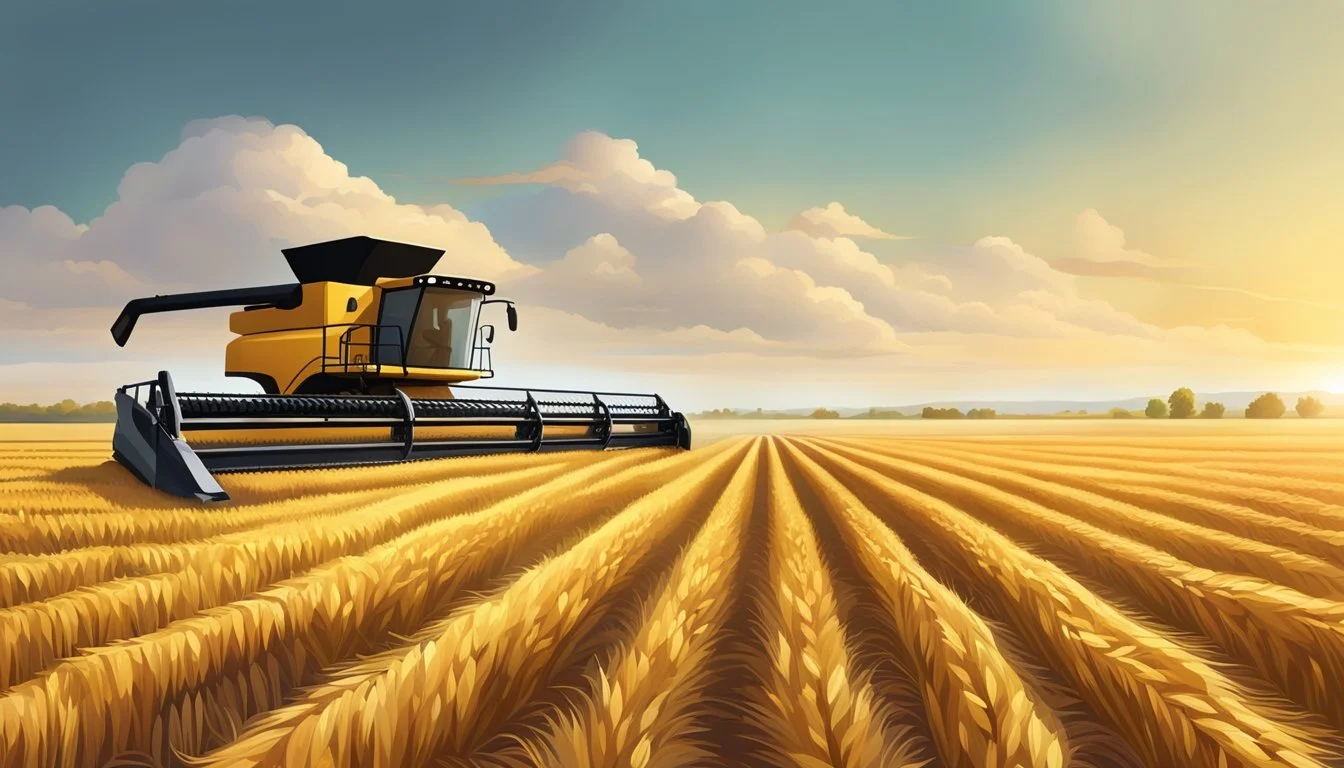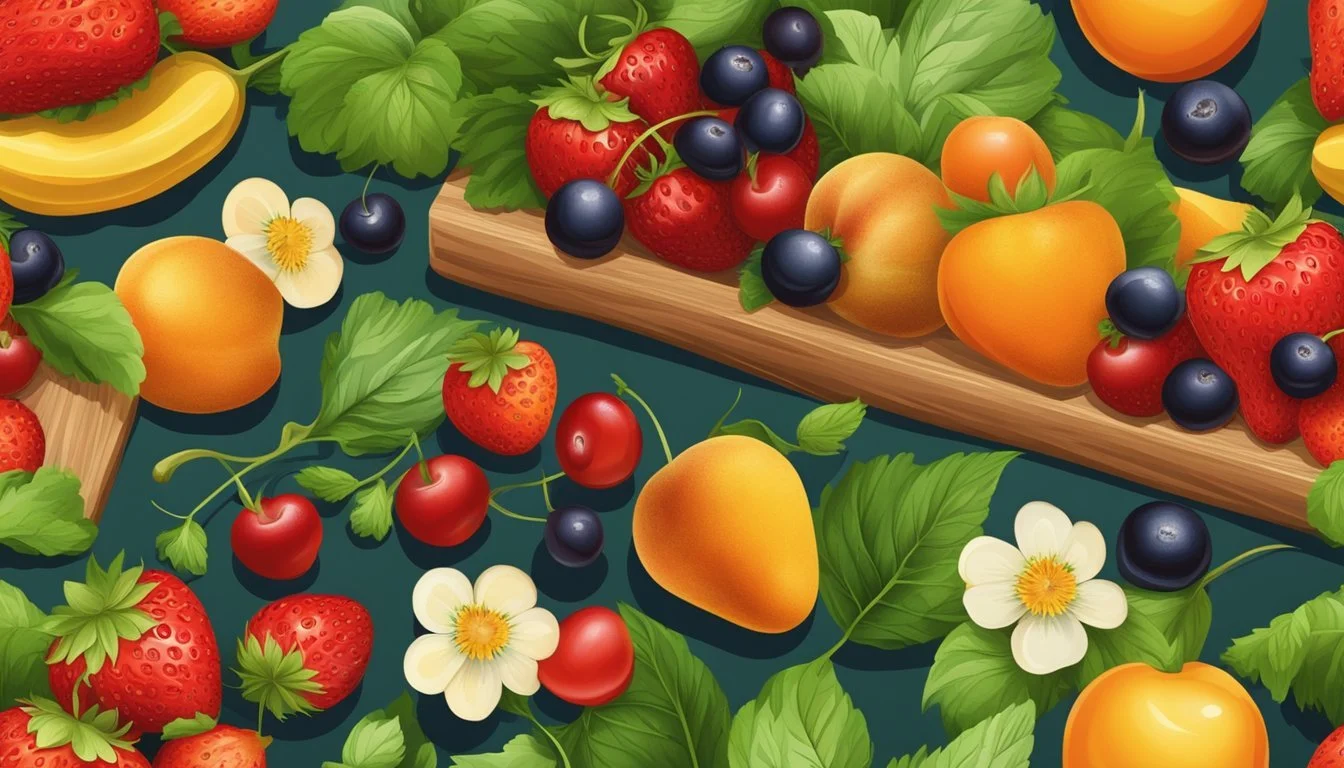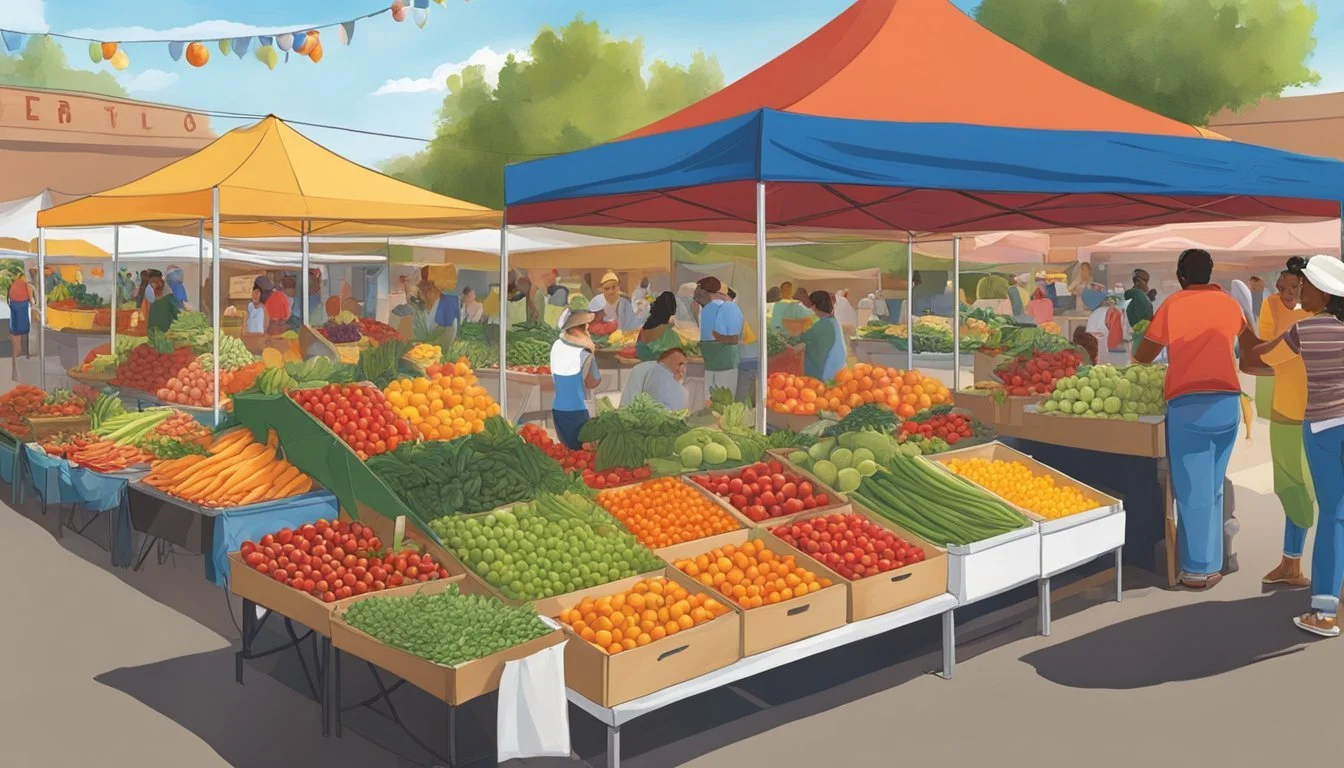Nevada Seasonal Fruit & Vegetables in June
Your Fresh Guide
This Article is Part of our Nevada Seasonal Fruit & Veg Calendar
In Nevada, June marks the transition into the bountiful summer season when local produce reaches its peak availability. As the temperatures rise, so does the variety of fruits and vegetables cultivated across the state's diverse growing regions. With the embrace of longer days comes a colorful assortment of produce that not only promises fresh flavors but also supports local agriculture and sustainability.
Residents and visitors alike can indulge in the freshness that June in Nevada has to offer. The month ushers in ripe blueberries (how long do blueberries last?), a favorite for their plump juiciness, and they are joined by a variety of greens such as chard, which thrives in the warm but not yet too hot climate. Moreover, vegetables like broccoli (how long does broccoli last?)and cauliflower (how long does cauliflower last?) find their harvest in the cooler pockets of the state, offering crispness to any dish.
Nevada's summer months are an opportune time to explore local farmers' markets where one can find not only seasonal fruits and vegetables but also connect with community growers. Eating seasonally not only provides a connection to the regional land and its seasons but also presents an opportunity to enjoy produce at its nutritional and flavorful peak. The array of produce available in June ensures that every meal can be rich in both taste and nutrients, supporting a healthy and enjoyable summer lifestyle.
Overview of Nevada's Growing Season
In Nevada, the growing season peaks in summer, with June heralding an array of in-season fruits and vegetables that are ripe for harvest. The state's climate plays a pivotal role in defining the seasonal produce available, contributing to the distinct flavors that characterize the region's agriculture.
Typical Climate and Conditions
Nevada is predominantly known for its arid desert climate, with hot summers and mild winters. Despite the challenging conditions, the state boasts a productive growing season, particularly in its northern and eastern regions which are categorized as USDA Zones 5-9. In June, the summer heat intensifies, creating an ideal environment for a variety of produce to thrive.
Noteworthy June Crops:
Fruits: Cherries (how long do cherries last?)
Vegetables: Corn, Cucumbers, Eggplant
These crops benefit from the warm days that help develop their flavor and maximize their harvest.
Importance of Seasonal Produce
Seasonal produce is essential for sustainable agriculture in Nevada. Fruits and vegetables harvested at the peak of their season require less transportation and storage, leading to reduced environmental impact and enhanced freshness. For consumers, in-season selections often offer better taste and nutritional value.
During June, Nevadans enjoy summer crops which are often fresher and more vibrant in flavor compared to out-of-season counterparts. By focusing on what's in season, the state supports local farmers and encourages regional economic stability, ensuring a continued cycle of high-quality, seasonal produce for the market.
June Availability List
June in Nevada offers a variety of fresh produce as the transition from spring to summer brings a bounty of fruits and vegetables. Farmers' markets and local producers supply an assortment of seasonal delights.
Seasonal Fruits
Berries: Strawberries come to a sweet peak earlier in the month.
Cherries: Cherries burst into the scene, offering a juicy and vibrant choice.
Apricots: The short season of apricots makes them a prized pick.
Melons: As the month progresses, melons begin to appear, hinting at the oncoming summer heat.
Seasonal Vegetables
Summer Squash: Zucchini and other summer squashes become readily available.
Greens: Leafy greens maintain their presence but start to wane as the heat intensifies.
Tomatoes: Tomatoes start to flourish, with early varieties ripening.
Peas & Beans: Snap peas and beans are often harvested in June, offering crisp freshness.
Cucumbers: These cool, crisp vegetables start to emerge for the summer salad season.
Health Benefits of Seasonal Eating
Eating fruits and vegetables in their respective seasons can greatly benefit one's health. They offer a variety of vital nutrients essential to maintaining a well-functioning body. Seasonal produce tends to be fresher, tastier, and more nutritious than their off-season or shipped counterparts.
Nutritional Value:
Peak Freshness: Fruits and vegetables consumed during their natural harvest season contain optimal levels of vitamins and minerals.
Diverse Diet: Integrating seasonal items into meals encourages a varied diet, key for obtaining broad nutritional benefits.
Health Benefits:
Improved Health Outcomes: A diet rich in fresh, seasonal produce is associated with better overall health, including a reduced risk of chronic diseases such as obesity, diabetes, and cardiovascular disease.
Supports Local Agriculture: Eating seasonally often means eating locally, supporting community farmers and reducing the carbon footprint related to long transportation.
Nutritional experts recommend incorporating a mix of seasonal fruits and vegetables to reap the health advantages. In Nevada during June, residents can enjoy a bounty of fresh produce with excellent nutritional profiles. Here's what's typically in season:
Asparagus: (how long does asparagus last?) packed with fiber, folate, and vitamins A, C, E, and K.
Basil: provides antioxidants and has anti-inflammatory properties.
Beets: high in fiber, folate, and vitamin C.
Broccoli: a great source of vitamins K and C, and packed with fiber.
Carrots: rich in beta-carotene, fiber, vitamin K1, potassium, and antioxidants.
Consuming these foods at their seasonal peak not only supports an individual's health but also the health of the planet.
Tips for Selecting and Storing Produce
June brings a bounty of fresh fruits and vegetables to Nevada, each with unique ripeness indicators and storage needs. Proper selection and storage are key to maximizing flavor and nutrition while extending the life of the produce.
Checking for Ripeness
Fruit:
Apricots: Should be slightly soft to the touch and have a uniform golden-orange color.
Cherries: Look for plump, firm cherries with bright, glossy skins.
Vegetables:
Asparagus: Stalks should be firm and straight with tightly closed tips.
Basil: Leaves should be vibrant green without any dark or wilted spots.
Best Storage Practices
Fruit:
Store cherries in the refrigerator in a plastic bag. Consume within a few days for best taste.
Apricots ripen at room temperature. Once ripe, they can be refrigerated to slow further ripening.
Vegetables:
Keep asparagus fresh by trimming the ends and storing them upright in a container with water in the refrigerator.
To preserve basil, place stems in a glass of water, cover with a plastic bag, and refrigerate.
By adhering to these specific checking and storage tips, one can ensure that the produce they bring home maintains its best possible flavor and nutritional value until it's ready to be enjoyed.
Farming and Harvest Techniques
In Nevada, local farms utilize an array of techniques to cultivate a variety of fruits and vegetables during the month of June. Adherence to sustainable agriculture practices is increasingly important within the state, with farms implementing strategies that promote soil health, water efficiency, and biodiversity.
Soil Preparation: Nevada's soil requires meticulous preparation due to its low organic matter and potential for high pH levels. Farmers incorporate compost and employ crop rotation to enhance soil fertility and structure, supporting healthy plant growth.
Irrigation: Efficient water use is critical in Nevada's arid climate. Drip irrigation systems are favored for their precision, delivering water directly to the plant roots. This method conserves water and reduces evaporation losses, which is vital during the hot June weather.
Integrated Pest Management (IPM): To protect June harvests from pests, farmers employ IPM techniques which include monitoring crops regularly, using natural predators, and applying organic or minimal pesticides only when necessary. This balanced approach reduces chemical usage and promotes a safer environment.
Harvesting:
Asparagus: Harvested by hand to ensure proper size and quality.
Berries: Gently picked at peak ripeness for immediate sale or processing.
Leafy Greens: Cut in the cooler morning hours to preserve freshness.
Crop Type Harvest Technique Fruits Hand-picked Vegetables Cut or root-pulled
Local farms focus on training workers in these sustainable and effective harvesting practices to guarantee the best quality produce for consumers. The techniques also contribute to the prolonged viability of agriculture in Nevada’s unique climate and terrain.
Nevada's Farming Regions and Produce Varieties
Nevada's diverse farming regions contribute to its distinctive selection of produce. The state covers a vast area with notable variations in climate and soil, which are broadly grouped into several agricultural zones.
The Northern Region, encompassing areas like Reno, benefits from cooler temperatures, allowing for the cultivation of leafy greens and root vegetables. In contrast, the Southern Region near Las Vegas, with its warmer climate, is suitable for growing heat-loving crops such as tomatoes and peppers.
June Harvest
In June, Nevada's farmers see an uptick in harvest for a variety of fruits and vegetables:
Fruits:
Cherries
Strawberries
Vegetables:
Zucchini
Radishes
Lettuce
Spinach
Regional Varieties
Each region often specializes in certain varieties, shaping the state’s agricultural identity:
Northern Nevada:
Greens: Buttercrunch Lettuce, Red Sails Lettuce
Squashes: Scallop Patty Pan Squash
Southern Nevada:
Cacti Fruit: Opuntia ficus-indica (prickly pear)
Peppers: California Wonder Bell Pepper, Early Jalapeño
Farmers in Nevada adapt their practices to the semi-arid climate, focusing on crops that can thrive under water scarcity while still providing a bountiful yield. Drip irrigation and careful water management are particularly crucial to the success of these diverse crops across the state's distinct farming areas.
Recipes and Preparation Ideas
In June, Nevada’s seasonal produce offers a bounty ripe for culinary exploration. Asparagus, an early summer favorite, shines when simply grilled with olive oil, salt, and pepper, allowing its natural flavors to come through. Basil, flourishing from June to September, pairs wonderfully in pesto sauces, drizzled over sliced ripe tomatoes, or as a fresh accent in lemon basil sorbet.
For a refreshing salad, one could toss blueberries, available in June and July, with arugula (how long does arugula last?), a hint of lemon zest (how long does lemon zest last?), and a light vinaigrette. Carrots, in season starting August, can be roasted with honey and thyme to highlight their natural sweetness a bit earlier in the year. Beets, ready in July, lend themselves to earthy salads, balanced with tangy goat cheese and crunchy walnuts.
Cantaloupes (how long does cantaloupe last?), hitting their stride in mid-August, suggest the promise of sweet, cooling dishes, such as a chilled cantaloupe soup or a vibrant melon salsa to accompany grilled fish. Broccoli and cauliflower, both coming into season by August, are versatile — excellent whether steamed, stir-fried, or roasted with a dash of seasoning.
Here are some concise ideas for incorporating these ingredients into your culinary repertoire:
Grilled Asparagus: Olive oil, sea salt (how long does sea salt last?), cracked pepper, lemon wedges.
Pesto Sauce (how long does pesto sauce last?): Basil, garlic, pine nuts (how long do nuts last?), Parmesan cheese, olive oil.
Blueberry Arugula Salad: Fresh blueberries, arugula, lemon dressing, feta cheese.
Roasted Carrots: Carrots, honey, fresh thyme, salt.
Beet and Goat Cheese Salad: Roasted beets, goat cheese, walnuts, balsamic reduction.
Chilled Cantaloupe Soup: Pureed cantaloupe, lime juice, mint, pinch of salt.
Broccoli and Cauliflower Stir-fry: Fresh broccoli, cauliflower, soy sauce (how long does soy sauce last?), garlic, sesame oil (how long does sesame oil last?).
When cooking with seasonal produce, one experiences the height of flavor and nutrition, as fruits and vegetables are picked at their peak. Each ingredient can inspire a multitude of dishes, allowing the season’s best to shine on the plate.
Community Events and Farmers' Markets
In Nevada, local events and farmers' markets thrive during June, showcasing a range of seasonal produce that includes asparagus, blueberries, and a variety of herbs. Farmers' markets are integral to the community, providing residents and visitors with access to fresh, locally-sourced fruits and vegetables.
Bruce Trent Park Farmers Market: A notable gathering that takes place in Las Vegas. Residents can indulge in fresh June produce every Wednesday.
Location: 8851 Vegas Dr, Las Vegas, NV 89128
Hours: 2:00 p.m. - 8:00 p.m.
Fresh52 Farmers & Artisan Market: This market is celebrated for its commitment to local farmers and community connections.
Various Locations
Below is a snapshot of markets where one can find seasonal offerings during June:
Market Name Location Dates and Times Downtown Summerlin Farmers Market Downtown Summerlin Varies Southern Highlands Farmers Market Southern Highlands Varies Skye Canyon Park Farmers Market 10111 W Skye Canyon Parkway, Las Vegas, NV Thursdays, 2:00 p.m. - 8:00 p.m.
These community-oriented markets not only promote the importance of eating seasonally but also serve as social hubs where people can engage with local farmers, vendors, and one another. They often include live music, food tastings, and cooking demonstrations, enhancing the experience beyond mere shopping.
Farmers' markets in Nevada are not only about purchasing produce; they are vibrant events that celebrate the state's agricultural diversity and foster community spirit.
Supporting Local Agriculture
When consumers purchase locally grown fruits and vegetables in Nevada, they are investing in the state's economy and fostering sustainability. June marks the season for a variety of fresh produce that not only bursts with flavor but also provides a lifeline to the local farming community.
Local Economy:
By opting for local produce, such as blueberries and basil available in June, consumers directly contribute to the livelihood of Nevada farmers. This support helps to keep money within the community, promoting regional economic stability and growth.
Sustainability:
Sustainability thrives when food travels shorter distances from farm to table. Local produce does not require extensive transportation, thus reducing the carbon footprint associated with shipping goods across vast distances.
Seasonal Availability in June:
Fruits:
Blueberries
Apricots
Vegetables:
Basil
Beets
When these fruits and vegetables are bought locally, they are often harvested at their peak of ripeness, offering superior quality and taste. They also serve as a testament to the resilience of agriculture in an arid state like Nevada.
Consumers can support local agriculture by visiting farmer's markets, subscribing to food boxes from local farms, or choosing produce marked as "Nevada Grown" at grocery stores. Each purchase is a vote for local farmers, for the planet, and for the health of one's own community.









